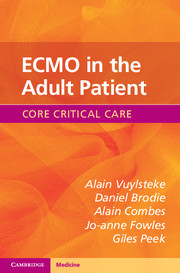Introduction
No one can remain on ECMO for ever. The goal should be to remove ECMO at the earliest opportunity.
In veno-venous ECMO, lung recovery will be awaited and liberation from ECMO support sought on a daily basis. It is striking how poor clinicians can be at predicting residual physiological reserves in patients. Veno-venous ECMO is particularly well suited to demonstrate this again and again at the bedside. A small number of patients may never be liberated and may be bridged to a lung transplant.
Veno-arterial ECMO is a support that gives time to the clinical team to evaluate the best next options. It can sometimes be used to bridge a patient to recovery but will usually allow stabilization and evaluation in preparation for other forms of treatment or support.
Liberating the patient on veno-venous ECMO
An easy test to assess patient readiness is to disconnect the gas sweep from the oxygenator (note: this should never be done in veno-arterial ECMO). All gas exchange will then have to be done by the patient’s lungs. Blood will simply circulate through the ECMO circuit with no consequence other than the mechanical stress imposed on its components. Veno-venous ECMO without a gas sweep can be continued for hours without any impact on a recovered patient. It can also be reinitiated at the ‘flick of a switch’ by starting the gas sweep.
Some centres will incorporate a daily automatic test off sweep. It is often surprising to see patients being able to ventilate fully despite being deemed too sick by the clinical team.
Clinical improvement is suggested by an improvement in lung compliance (estimated from tidal volume and pressure measured on the ventilator), radiological appearances, gas exchange and laboratory parameters.
Some clinicians advocate that there is no such action as weaning from the ECMO circuit, while others will advocate that a progressive wean can be instituted. This is similar to the discussions surrounding weaning a patient from a ventilator, and experience will differ from centre to centre.
Clinical adjustment to flow and sweep are continuously required to meet physiological targets while the patient is treated. ECMO flow will be decreased when the patient’s own oxygenation is improving (improved lung function or lower cardiac output). The gas sweep is affected by so many factors that it is wrong to believe it is a marker of progress in patient status. An example of a chart used to manage the pump and use the lowest possible setting is shown in Figure 11.1.

Figure 11.1 A veno-venous ECMO weaning algorithm. Example of an algorithm used by staff at the bedside to decrease the level of ventilatory support in patients on veno-venous ECMO. RR, respiratory rate.
If the patient has been supported adequately and lung function has recovered sufficiently, the ECMO can be removed.
Liberating the patient on veno-arterial ECMO
Liberating a patient from veno-arterial ECMO is usually a complex exercise, except when it simply entails moving to another form of mechanical support.
If the heart has fully recovered, it will be obvious that the two circulations are competing. The patient can then be taken to the operating room for the arterial cannula to be removed under direct surgical vision (blind removal of a percutaneous cannula is possible but not as safe).
If it is unsure that the heart recovery is sufficient to sustain physiological demand, there is no universal protocol. Similar measures to those used to come off cardiopulmonary bypass are used, and an expert team is required.
One key difference compared with cardiopulmonary bypass is that in veno-arterial ECMO the liberation attempt can be stopped while the team review plans, including the possibility of non-reversibility or long-term support.
Various protocols have been proposed and several indices suggested as indicators of success, but none replaces experienced cardiac surgical teams in this endeavour.
End-of-life care
Mortality in patients receiving ECMO remains high, and clinicians will often have to manage the end of a life.
This can be extremely difficult in situations where the pump is keeping the patient alive and there is no possibility of progression to further treatment or support. Patients may be fully awake and aware, and support to them, their family and the staff is necessary.
Clear and consistent communication between the ECMO team and families, balancing hopes of recovery with realistic estimates of the risk of dying, is key in preparing for difficult decisions at the end of life. Involvement of specialist palliative care physicians and nurses can be very valuable.
Many patients may have recorded a prior wish to consider organ donation, and the opportunity to discuss potential organ and/or tissue donation should be offered. This is done in accordance with local guidance.
Key points
Liberation from veno-venous ECMO can follow protocol.
Interruption of the gas sweep in patients on veno-venous ECMO is a good test to assess whether ECMO is still required.
Gas sweep should never be interrupted in patients on veno-arterial ECMO.
Liberation from veno-arterial ECMO is easy when obvious, but complex and unsure when not.


